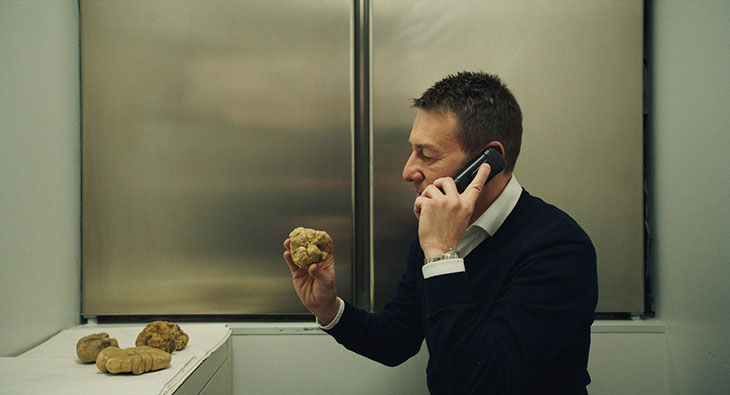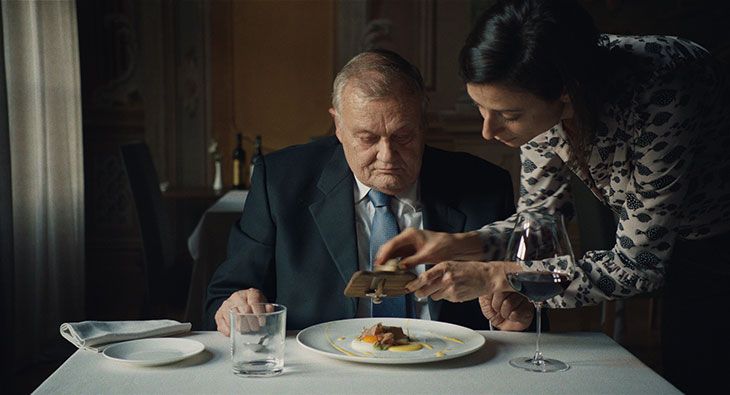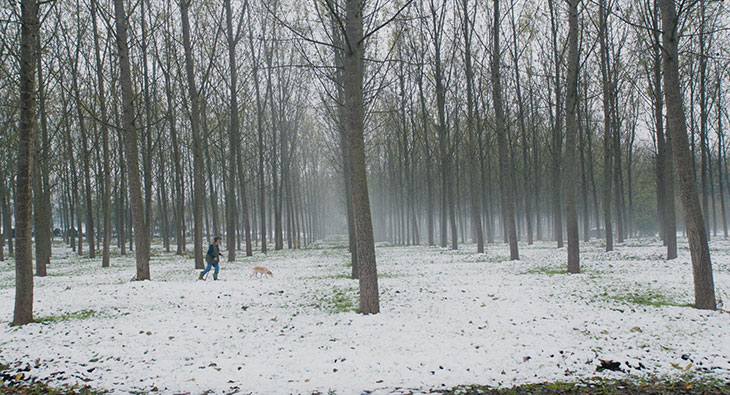An exhibit lies on a red plush cushion atop a silver stand. A crowded audience looks on and cameras flash, while an auctioneer calls higher and higher bids in multiple languages. The object under the hammer is not a historic painting or a sparkling jewel. It is a white truffle from the northern Italian region of Piedmont. The auction of the prized fungus is captured in The Truffle Hunters (2020), a beautifully shot documentary full of painting-like tableaux, which explores the highly secretive (and lucrative) business of hunting and selling white truffles – revealing surprising parallels with the luxury art and jewellery markets.
White truffles are tubers that grow beneath the earth in symbiosis with trees such as oak, hazel and poplar. They are hunted using expertly trained dogs that sniff out the truffle’s pungent aroma. White truffles are most famously dug up in the countryside around the Piedmontese city of Alba – the white truffle is also dubbed the Alba truffle – but they are found throughout the nearby areas of Langhe and Montferrat as well as in Acqualagna in the region of Le Marche, some 500 kilometres south-west of Alba. Their potent, earthy flavour and aroma infuse the dishes of some of the finest restaurants around the world. The misshapen nuggets can fetch around €2,000–€5,000 depending on their weight. The biggest and best, though, can go for eye-watering sums at auction. In 2019, at the 20th edition of the annual Alba White Truffle World Auction, a specimen weighing 1 kilo and 5 grams sold for €120,000 to a buyer from Hong Kong.
When at auction, the white truffle hardly seems like a foodstuff. In preparation for sale, a truffle is cleaned meticulously . In his book The Truffle Underground (2019), Ryan Jacobs compares the ‘delicate process’ to the restoration of fine art: ‘In a way, they were brushing the dirt layers off the truffle to give consumers the highest experience of the art.’ Expert dealers then carefully inspect the cleaned exhibits, peering closely at the surface texture, analysing the form, pouncing on any imperfections. Then they inhale deeply, nose millimetres from the precious object.
Still from The Truffle Hunters (2020; dir. Michael Dweck and Gregory Kershaw). Courtesy Sony Pictures Classics

At the International Alba White Truffle Fair, held each year between October and December, the knobbly beige tubers are set out on stands with information labels. The best specimens might be presented on glass display plates or in wooden boxes. At the auction featured in The Truffle Hunters, a team of smartly dressed women parade up to the table and ceremonially place the velvet cushion on the stand, framing it with bottles of wine.
Even when people describe its powerful scent, it sometimes seems like the truffle’s edibility is barely relevant. The food writer Josh Ozersky once called the aroma ‘a combination of newly plowed soil, fall rain, burrowing earthworms and the pungent memory of lost youth and old love affairs’.
As with the art trade, the great sums at stake mean there is a motive for dirty dealing and underground markets have emerged. The situation has been aggravated by a diminishing supply of the fungus in Piedmont due to rises in temperature and a reduction in rainfall caused by climate change. The white truffle, unlike the black variety, is a spontaneous fungus meaning it currently cannot be cultivated to produce greater quantities. The scarcity of white truffle is also exacerbated by the tendency for truffle hunters to carefully guard their knowledge of where they find the tubers. If a hunter does not have children, it’s very possible this information will die with him.
Still from The Truffle Hunters (2020; dir. Michael Dweck and Gregory Kershaw). Courtesy Sony Pictures Classics

At Alba’s truffle fair, a panel of expert judges carries out a ‘sensory analysis’ of all the truffles that traders wish to present. In a scene in The Truffle Hunters, one judge frustratedly rejects truffles with crevices packed with soil to increase the weight or previously declined specimens being passed off as new. The tubers that pass the test are weighed, counted and numbered before going on sale. The committee of sensory experts is also on hand for any novice buyers concerned about being duped. Buyers have to watch out for imperfections concealed with mud or worm infestations. With such a restricted supply of Alba white truffle, the market has also been infiltrated with specimens masquerading as Piedmontese but in reality from other locations around Italy or even from Croatia’s Istrian Peninsula.
In other market channels, it’s a case of having good contacts – plus a keen eye and a sharp nose. Piazza Duomo is one of Alba’s most renowned restaurants and boasts three Michelin stars. Chef Enrico Crippa has white truffle on the menu every season, meaning he needs to source around 20 to 30 kilos each time. In an email, Crippa says building a strong relationship with a trusted vendor is essential. But as for judging quality and aroma, it is all down to practice. ‘I needed more than 10 years to have that kind of experience,’ Crippa says. An experienced buyer will turn the proffered specimens over carefully, breathing in the scent and assessing the form: for restaurants, a shapely form is desirable when showing off the truffle to customers. Pricing a truffle, however, is not just a case of evaluating quality, size or maturity. ‘The price of the truffle changes daily,’ Crippa explains, ‘The market must be carefully monitored day after day.’
Still from The Truffle Hunters (2020; dir. Michael Dweck and Gregory Kershaw). Courtesy Sony Pictures Classics

The darker side of the business is fully acknowledged in The Truffle Hunters. The film may have won over audiences with its heartwarming scenes of elderly men doting on their hunting dogs, which accompany them on treks through snowy woods both day and night. But running throughout is a current of wariness and even disillusionment with the whole business. One of the truffle hunters has renounced the trade because he feels people have become too greedy. They trespass on other peoples’ property and ‘plunder’ the land, hunting truffles only for money rather than passion. At one point, he confronts a trader who is trying to persuade him to return to hunting. He accuses the trader of dishonesty and selling on the black market. In another scene, a distraught hunter explains to a policeman that his dog has been poisoned – most probably by a cut-throat competitor. It is not uncommon for spiked meat to be hidden among the undergrowth and dogs may also mysteriously disappear.
Plagued by fraud, best understood by its cognoscenti, and extremely lucrative, the white truffle industry is clearly one that art dealers may recognise. And in fact, the two worlds have been known to collide even more directly. In 2014, Sotheby’s New York made a foray into truffle sales, auctioning off what was at the time the world’s largest white truffle. The sale brought in $61,250.
The Truffle Hunters (2020; dir. Michael Dweck and Gregory Kershaw) is now in cinemas in the UK.


